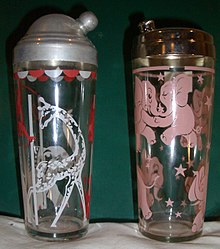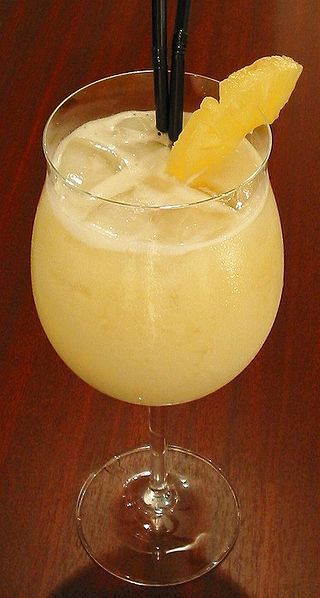
The piña colada is a cocktail made with rum, cream of coconut or coconut milk, and pineapple juice, usually served either blended or shaken with ice. It may be garnished with either a pineapple wedge, maraschino cherry, or both. The drink originated in Puerto Rico.

A cappuccino is an espresso-based coffee drink and is traditionally prepared with steamed milk foam (microfoam).
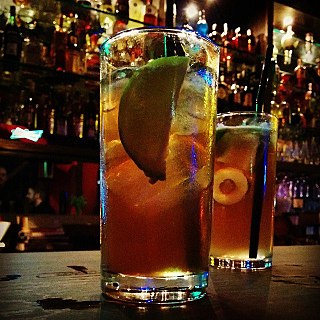
The Long Island iced tea, or Long Island ice tea, is an IBA official cocktail, typically made with vodka, tequila, light rum, triple sec, gin, and a splash of cola. Despite its name, the cocktail does not typically contain iced tea, but is named for having the same amber hue as iced tea.

The martini is a cocktail made with gin and vermouth, and garnished with an olive or a lemon twist. Over the years, the martini has become one of the best-known mixed alcoholic beverages. A popular variation, the vodka martini, uses vodka instead of gin for the cocktail's base spirit.

A drink can is a metal container designed to hold a fixed portion of liquid such as carbonated soft drinks, alcoholic drinks, fruit juices, teas, herbal teas, energy drinks, etc. Drink cans are made of aluminum or tin-plated steel. Worldwide production for all drink cans is approximately 370 billion cans per year.

A cocktail glass is a stemmed glass with an inverted cone bowl, mainly used to serve straight-up cocktails. The term cocktail glass is often used interchangeably with martini glass, despite their differing slightly. Today, the glass is used to serve a variety of cocktails, such as the martini and its variations, Manhattan, Brandy Alexander, pisco sour, Negroni, cosmopolitan, gimlet, and the grasshopper.

Various unique terminology is used in bartending.

"Shaken, not stirred" is how Ian Fleming's fictional British Secret Service agent James Bond prefers his martini cocktail.

Beer glassware comprise vessels made of glass, designed or commonly used for serving and drinking beer. Styles of glassware vary in accord with national or regional traditions; legal or customary requirements regarding serving measures and fill lines; such practicalities as breakage avoidance in washing, stacking or storage; commercial promotion by breweries; artistic or cultural expression in folk art or as novelty items or usage in drinking games; or to complement, to enhance, or to otherwise affect a particular type of beer's temperature, appearance and aroma, as in the case of its head. Drinking vessels intended for beer are made from a variety of materials other than glass, including pottery, pewter, and wood.

A cocktail strainer is a metal bar accessory used to remove ice from a mixed drink as it is poured into the serving glass. A type of sieve, the strainer is placed over the mouth of the glass or shaker in which the beverage was prepared; small holes in the device allow only liquids to pass as the beverage is poured.

The old fashioned glass, otherwise known as the rocks glass and lowball glass, is a short tumbler used for serving spirits, such as whisky, neat or with ice cubes. It is also normally used to serve certain cocktails, such as the old fashioned. The true old fashioned glass is decorated in the cut glass style, although most modern examples are pressed glass, made using a mold. The design is essentially English, from the late 18th or 19th-century. Plain glass versions are lowball glasses.
A pony glass may mean one of two types of small glassware:
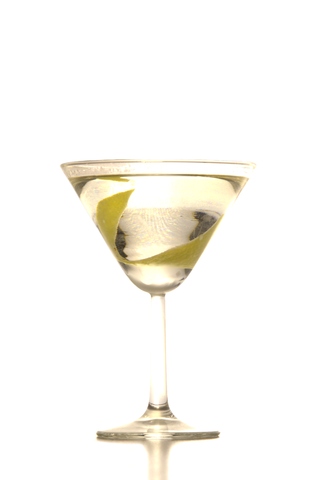
The Vesper is a cocktail that was originally made of gin, vodka, and Kina Lillet. Since that form of Lillet is no longer produced, modern bartenders need to modify the recipe to mimic the original taste.

The Ward 8 or Ward Eight is a cocktail originating in 1898 in Boston, Massachusetts, at the bar of the Gilded Age restaurant Locke-Ober.
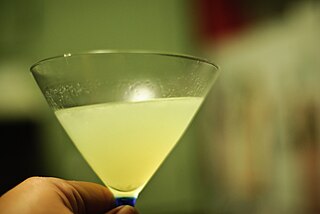
The last word is a gin-based Prohibition-era cocktail originally developed at the Detroit Athletic Club. While the drink eventually fell out of favor, it enjoyed a renewed popularity after being rediscovered by the bartender Murray Stenson in 2003 during his tenure at the Zig Zag Café and becoming a cult hit in the Seattle area.

A Clover Club cocktail is a shaken cocktail consisting of gin, lemon juice, raspberry syrup, and egg white. The egg white acts as an emulsifier, forming the drink's characteristic foamy head.
Caffè crema refers to two different coffee drinks:

A hurricane glass is a form of drinking glass which typically will contain 20 US fluid ounces. It is used to serve mixed drinks, particularly the Hurricane from which it is named originating at Pat O'Brien's Bar in New Orleans. Other drinks served in this glass include the Singapore Sling, June bug, piña colada and Blue Hawaii. It is shaped similarly to a vase or a hurricane lamp and is typically taller and wider than a highball glass.

